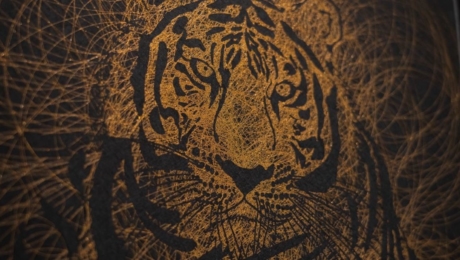

Ryukobo: Kumihimo Reimagined for Interior Design
2024.10.30
LIFERyukobo has been creating authentic kumihimo (traditional Japanese braiding) for over 130 years, their exceptional craftmanship treasured by tea ceremony masters, kabuki actors, and even the Japanese imperial family. The high-quality kumihimo produced here is no longer limited for use with traditional kimono sashes, but is now expanding into accessories, sundry small items, and even art pieces for interiors and home decor.
At the center of this new venture is fifth-generation Ryuta Fukuda, whose father, Takashi Fukuda, was designated a Contemporary Master Craftsman by the Ministry of Health, Labor and Welfare of Japan. Fukuda sees tremendous potential in kumihimo not just for its traditional beauty, but also as a form of artistic expression.
“For artisans who create traditional crafts, one option is to aim to become a so-called Living National Treasure by perfecting their techniques. But for us, it’s more about preserving the techniques of kumihimo and ensuring the Ryukobo name lives on. To do that, we need to introduce kumihimo to a wider audience. Along with creating hit products, I feel that kumihimo has untapped potential as an art form for interiors and home decor,” says Fukuda.

Ryukobo’s interior design journey began when they were commissioned by a famous French luxury maison to design the interior of its Japan-based store. They sought a company capable of meeting their high standards, and Ryukobo’s persistent efforts earned their trust and admiration. The result was 550 pure white kumihimo cords, each several times thicker than a traditional cord for obi sashes, and nearly seven meters long—resembling the ropes used to anchor ships. The total weight came to two tons.
“To use kumihimo in interiors, you must adhere to regulations in accordance with the Building Standard Law and Fire Service Act. This requires knowledge of fire-resistant materials and prevention methods, along with the skills to implement them. Learning these things has broadened the scope of Ryukobo’s work,” Fukuda explains.
Kumihimo’s advantages go beyond aesthetics; its functionality also shines. For instance, partitions made of kumihimo became popular during the COVID-19 pandemic due to their breathability and transparency, while also meeting security needs—offering privacy without total concealment. Additionally, large woven kumihimo panels, unlike fabrics, can display different designs on the front and back, making them a versatile choice.

One of the major benefits of using kumihimo for interiors is that individual cords can be replaced. This allows for ongoing maintenance and adjustments, offering not just one-time installations, but long-term care. This also has significant value from the perspective of preserving traditional techniques, as continued maintenance work ensures that the craft endures. Fukuda remarks that the continuous evolution of kumihimo gives him great satisfaction.
“You can feel that collaborating with new technologies is transforming the value of kumihimo and elevating our craft. The things we can express with kumihimo are evolving with the times. My dream is to make kumihimo a standard part of everyday life, wherever you go. It’s a long journey, but I’m determined to see it through.”
As a pioneer in this field, Fukuda is particularly interested in incorporating kumihimo into lighting fixtures, which play a crucial role in both interior design and art. He is also exploring collaborations with custom home builders to bring kumihimo into private homes, further integrating the craft into daily life.

Ryukobo’s mastery of the entire process—from thread making, dyeing, design, and braiding—has allowed them to successfully evolve kumihimo into an art form for interior design, creating new value for the craft. As Fukuda looks to the future, he remains committed to continually pushing the boundaries of kumihimo, envisioning a bright future for this traditional art.






